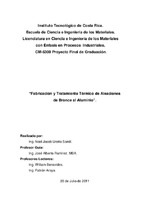Fabricación y tratamiento térmico de aleaciones de bronce al aluminio.
Resumen
Este proyecto, fue desarrollado en el Centro de Investigación y Extensión en Ingeniería de los Materiales (CIEM) de la Escuela de Ciencia e Ingeniería de los Materiales.
En el año 2008, se exportaron en desperdicios y desechos 15,9 millones de dólares estadounidenses (US$) de cobre; 14,4 millones de US$ de aluminio y 29,5 millones de US$ hierro o acero.
Como alternativa para el aprovechamiento de estos desechos, se propone la fabricación de aleaciones de bronce al aluminio, tratables térmicamente, con alta resistencia a la corrosión y a la cavitación, entre otras propiedades.
Se fabricó dos aleaciones, una con 84,6% Cu; 11,2% Al y 2,9% Fe. Otra con 83,1% Cu; 10,3% Al; 5,67% Fe, que fueron sometidas a temples desde 950°C hasta los 20°C y desde los 950°C hasta los -196°C. Así como, Se realizó revenidos a 550, 600, 650 y 700°C por dos horas.
La dureza, por lo general, subió luego de los temples. Se descartó la influencia del temple criogénico sobre la dureza o la microestructura. Los temples provocaron la formación de la microestructura acicular martensítica (β’ sobre base α). Los revenidos a 550, 600 y 650°C, ablandaron las probetas dela aleación Cu-11%Al-3%Fe, mientras la microestructura cambiaba a granos más grandes de forma redondeada constituidos por solución sólida α y fase de composición variable α+γ2. Luego del revenido a 700°C, la dureza se incrementó, posiblemente, por una cantidad muy alta del compuesto intermetálico γ2. 15.9 million dollars of copper waste, 14.4 million of aluminum scrap and 29.5 million dollars of steel and iron waste were exported from Costa Rica during 2008. The fabrication of heat treatable aluminum bronze alloys, from those materials, is proposed to take a better advantage of them. These aluminum bronze alloys are highly resistant to corrosion and cavitation among some other properties. The alloys that were casted and studied had the following composition: 84.6% Cu, 11.2% Al and 2.9% Fe. As well as: 83.1% Cu, 10.3% Al, and 5.67% Fe. They were quenched from 950°C (1742°F) to 20°C (68°F) and from 950°C (1742°F) to -196°C (-320°F). The quenched samples were tempered 2 hours at different temperatures: 550, 600, 650 and 700°C (1022, 1112, 1202 and 1292°F). In general, after the quenching, the hardness of the alloys went up, compared with the as-cast hardness. The cryogenic quenching did not have any effect upon the microstructure nor the hardness of the alloys. The quenching treatments caused the β’, acicular martensitic microstructure, to appear. The increase in the tempering temperature (550, 600 and 650°C) for the Cu-11%Al3%Fe alloy, caused a softening of the samples, while the microstructure of the alloys changed to larger grains made of the α solid solution and the variable composition phase α+γ2. For the 700°C the hardness increased again, most likely because of the presence in a larger quantity of the intermetallic compound γ2
Descripción
Proyecto de Graduación (Licenciatura en Ingeniería en Materiales) Instituto Tecnológico de Costa Rica, Escuela de Ciencia e Ingeniería de los Materiales, 2011


